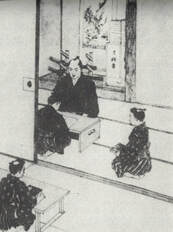SAMURAI EDUCATION

From the Ashikaga period (1392-1568), a young samurai who aspired to become a great warrior would seek guidance from a competent master. If this master was the founder or legitimate successor of a combative martial ryū, entrance prerequisites may have included a letter of reference and pledge of allegiance (血判 keppan). Upon gaining entrance, the young samurai would have entered the 手解き物 tehodoki, untying of hands, a probationary period during which a candidate's suitability for membership would have been evaluated.
During the Tokugawa period (1603-1867), a belief that scholastically trained samurai would make better administrators gradually led to a proliferation of fief-sponsored schools and increased literacy, especially among members of the upper class. By the end of the period, a majority of male samurai children were receiving formal education in one of more than 200 fief schools. The fief schools were characterized by a reverence for knowledge and for the teacher, and by a common insistence on the need for a serious-minded approach to learning aimed at developing character and skill.
The main organizing principle of the fief schools was discipleship. A student was the student of a particular teacher. If fees were paid, they were paid directly to the teacher. Irrespective of subject, the teacher-student relationship remained central, especially in the martial arts. The martial or combative arts were taught by samurai who possessed a mastership license (menkyo) from a particular ryū. If a student wanted to learn a particular type of martial art, such as kenjutsu (sword-art), he must find a teacher who possessed a mastership license in kenjutsu. All military appointments required at least one mastership license in a combative art.
During the Tokugawa period (1603-1867), a belief that scholastically trained samurai would make better administrators gradually led to a proliferation of fief-sponsored schools and increased literacy, especially among members of the upper class. By the end of the period, a majority of male samurai children were receiving formal education in one of more than 200 fief schools. The fief schools were characterized by a reverence for knowledge and for the teacher, and by a common insistence on the need for a serious-minded approach to learning aimed at developing character and skill.
The main organizing principle of the fief schools was discipleship. A student was the student of a particular teacher. If fees were paid, they were paid directly to the teacher. Irrespective of subject, the teacher-student relationship remained central, especially in the martial arts. The martial or combative arts were taught by samurai who possessed a mastership license (menkyo) from a particular ryū. If a student wanted to learn a particular type of martial art, such as kenjutsu (sword-art), he must find a teacher who possessed a mastership license in kenjutsu. All military appointments required at least one mastership license in a combative art.
INSTRUCTION AT UNRY DOJO
Today, there are a wide variety of approaches to teaching, even among dojo that specialize in traditional Japanese martial arts. The main elements of our approach include:
Today, there are a wide variety of approaches to teaching, even among dojo that specialize in traditional Japanese martial arts. The main elements of our approach include:
- Emphasis on good manners, formal and informal Japanese-style martial etiquette;
- Individualized instruction, one-to-one, delivered primarily through demonstration, non-verbal instruction;
- Reliance on formal kata (two-person forms, resembling single-combat) to teach the gendai and koryu bujutsu; and,
- Commitment to training (稽古 keiko and 修行 shugyo), practicing kata over and over with occasional "corrections" from the instructor.
|
先生 HEAD INSTRUCTOR
Mark Toth began studying traditional Japanese martial arts at Futen Dojo (Milwaukee, WI) in 1993. In 2002, at the request of his teacher, Mr. Toth began taking a leadership role by creating a club system (Kobudo Club) to promote Genbukan martial arts at Wisconsin universities. By 2004, clubs had been established at three Wisconsin universities. The following year, 2005, Grandmaster Tanemura awarded Mr. Toth the title, Dojocho ("School Director"). Today, Mr. Toth operates his traditional school, Unryu Dojo, in south-eastern Pennsylvania. Mr. Toth has received a San (3rd) Dan rank (modern kyu-dan system) in both Genbukan Taijutsu and KJJR Jujutsu as well as a Shoden-menkyo (1st mastership level, traditional menkyo system license) in more than a dozen koryu bujutsu, including Asayama Ichiden Ryu Taijutsu, Daito Ryu Aiki Jujutsu, and Kuki-Shinden Ryu Taijutsu (unarmed system), Bikenjutsu (sword system), and Bojutsu (staff system).
|
CONTACT US
Anyone can learn traditional Japanese martial arts. All that is needed is a sincere desire to learn and perseverance. If you are sincere in your desire to learn traditional Japanese martial arts and willing to commit to regular training, we invite you to contact us.
Anyone can learn traditional Japanese martial arts. All that is needed is a sincere desire to learn and perseverance. If you are sincere in your desire to learn traditional Japanese martial arts and willing to commit to regular training, we invite you to contact us.
|
Unryu Dojo is an official branch of the Genbukan Honbu Dojo, Saitama, Japan, Shoto Tanemura headmaster (soke/soshi) and president (kancho). SamuraiTrainingCenter.com, PhillySamurai.com, and PhillyNinja.com are registered domains of Unryu Dojo. © 2009-2024 Unryu Dojo. All rights reserved. Reproduction in whole or in part in any form without express permission is strictly prohibited.
Anyone can learn traditional Japanese martial arts. All that is needed is a sincere desire to learn and perseverance. If you are sincere in your desire to learn, we invite you to contact us. |
